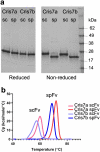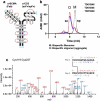"Stapling" scFv for multispecific biotherapeutics of superior properties
- PMID: 37074212
- PMCID: PMC10120459
- DOI: 10.1080/19420862.2023.2195517
"Stapling" scFv for multispecific biotherapeutics of superior properties
Abstract
Single-chain fragment variable (scFv) domains play an important role in antibody-based therapeutic modalities, such as bispecifics, multispecifics and chimeric antigen receptor T cells or natural killer cells. However, scFv domains exhibit lower stability and increased risk of aggregation due to transient dissociation ("breathing") and inter-molecular reassociation of the two domains (VL and VH). We designed a novel strategy, referred to as stapling, that introduces two disulfide bonds between the scFv linker and the two variable domains to minimize scFv breathing. We named the resulting molecules stapled scFv (spFv). Stapling increased thermal stability (Tm) by an average of 10°C. In multiple scFv/spFv multispecifics, the spFv molecules display significantly improved stability, minimal aggregation and superior product quality. These spFv multispecifics retain binding affinity and functionality. Our stapling design was compatible with all antibody variable regions we evaluated and may be widely applicable to stabilize scFv molecules for designing biotherapeutics with superior biophysical properties.
Keywords: Multi-specific antibody; Scfv; Scfv stabilization; Single chain fv; Spfv; Stapled scfv.
Conflict of interest statement
JL, LEB, MF, MD, AAA, AT & CH are co-inventors in a provisional patent application (US20210047435A1). This application covers the scFv stapling technology and its potential applications in multispecific antibodies and other therapeutic or diagnostic protein modalities and detection reagents wherever scFv can normally be used.
Figures







References
MeSH terms
Substances
LinkOut - more resources
Full Text Sources
Other Literature Sources
